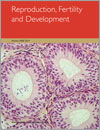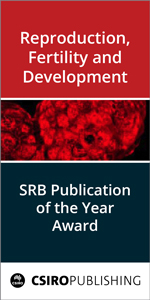This review summarises the striking novelties obtained from morphophysiological investigations after David W. Hamilton stated ‘epididymal basal cells are an enigma’ in the 1970s. In addition to an earlier hypothesised scavenger role linked to the expression of macrophage antigens, basal cells have been shown to be involved in cell–cell cross-talk and to function as luminal sensors regulating epithelial activity.

Reproduction, Fertility and Development
Volume 26 Number 8 2014
RD13178Mitochondrial SIRT5 is present in follicular cells and is altered by reduced ovarian reserve and advanced maternal age
Young women whose eggs age prematurely or women over 40 have reduced fertility. Our study shows that the follicular cells of these women have reduced activity of a mitochondrial protein, SIRT5, that alters the activity of enzymes resulting in an accumulation of ammonium in the follicular fluid that bathes the egg. This altered follicular-fluid composition may contribute to the reduced egg quality in these women.
RD12332Triphenyltin chloride induces spindle microtubule depolymerisation and inhibits meiotic maturation in mouse oocytes
Triphenyltin chloride (TPTCL) is a highly bioaccumulated and toxic environmental oestrogen; however, its effect on oocyte meiosis remains unknown. In this study we examined the effect of TPTCL on mouse oocyte meiotic maturation in vitro and in vivo and found that TPTCL seriously affects meiotic maturation by disturbing cell-cycle progression and the microtubule cytoskeleton. Our study may be helpful for investigating infertility and miscarriage of undetermined origin.
RD13190Predictive value of antral follicle count and anti-Müllerian hormone for follicle and oocyte developmental competence during the early prepubertal period in a sheep model
Factors and mechanisms driving early prepubertal follicle development still need to be completely elucidated. Here, we found that antral follicle count (AFC) could represent a sign of follicular maturation in the prepubertal ovaries, while its close relationship with the non-growing follicle pool could develop only after the full establishment of reproductive activity. These data extend our knowledge of the ovarian functionality during the early prepubertal period.
RD13218Altered chromatin condensation of heat-stressed spermatozoa perturbs the dynamics of DNA methylation reprogramming in the paternal genome after in vitro fertilisation in cattle
Shortly after fertilisation, methylation of both maternal and paternal DNA is reprogrammed for further embryo development. The objectives of this study were to investigate DNA methylation reprogramming following fertilisation of oocytes with heat-stressed spermatozoa and the results show that the normal pattern of DNA methylation reprogramming is perturbed in the paternal genome, leading to a lower fertilisation rate. Our data can be used to address lower fertilisation potential of spermatozoa with suboptimal quality.
RD13181Isolation, characterisation and cDNA sequencing of a new form of parvalbumin from carp semen
Parvalbumins are calcium-binding proteins and their presence in carp semen may be related to the importance of calcium ions in the mechanism controlling carp sperm movement. We aimed to purify and characterise the new form of carp seminal parvalbumin (Pv-II), which differed from other carp parvalbumins and had a tendency to oligomerise. The oligomerisation was protected by the presence of seminal plasma. The results suggest the role of parvalbumin in mechanism of carp sperm activation and spermatozoa protection against apoptosis.
RD13099Cryotolerance and global gene-expression patterns of Bos taurus indicus and Bos taurus taurus in vitro- and in vivo-produced blastocysts
The major challenge for a greater dissemination of in vitro-produced bovine embryos is to improve embryonic survival after cryopreservation. The results generated in this study provide different transcriptomic signatures of a model with two bovine subspecies and two embryo origins that presented distinct lipid content and post-cryopreservation survival. Such knowledge will be useful to characterise the specific role of identified genes in lipid metabolism and embryo cryosurvival capacity.
RD13118LAPS-FSH: a new and effective long-acting follicle-stimulating hormone analogue for the treatment of infertility
As FSH has relatively short half-life, there is a great need for the development of a long-acting FSH analogue with increased efficacy. A new FSH analogue, LAPS-FSH, demonstrates several advantages such as a long half-life, good potency, and ability to increase the number of Graafian follicles and the size of the follicles. LAPS-FSH is expected to increase the success rate of infertility treatments while also reducing the effort and time.
RD13139The pattern of LH secretion and the ovarian response to the ‘ram effect’ in the anoestrous ewe is influenced by body condition but not by short-term nutritional supplementation
The food animals eat has a major influence on their ability to reproduce. This experiment was designed to determine if fatness or high-energy diets affected the socio-sexual responses of ewes to rams. High-energy diets stimulated insulin and glucose but had little influence on reproductive responses. Thin ewes had reduced glucose and insulin and compromised responses to socio-sexual stimulation, suggesting that fatness was a significant contributor to reproductive success.
RD13169EZH2 is essential for development of mouse preimplantation embryos
Ezh2 controls the fate of mouse embryos at an early stage. We investigated Ezh2 expression during preimplantation and found that lacking Ezh2 results in mouse embryos with severe development defects. Our results showed that Ezh2 affect mouse embryo development through the regulation of epigenetic modification, gene expression and apoptosis.
RD13207Y chromosome in Turner syndrome: detection of hidden mosaicism and the report of a rare X;Y translocation case
The presence of Y-chromosome material in Turner syndrome is of medical importance because it results in an increased risk of developing gonadal tumours and virilisation. We detected cryptic Y-chromosome sequences in 2.7% of cases and describe one girl with a very uncommon karyotype 46,X,der(X)t(X;Y)(p22.3?2;q11.23). We recommend that the search for Y-chromosome mosaicism should be carried out in all Turner cases.
RD13162Spermatozoa of the old endemic rodents of Australia – the possible functional significance of their ventral processes
Most Australian old endemic rodents contain a highly complex spermatozoon with the head containing two processes extending from its upper concave surface. This study investigates the structure and function of these processes. It shows that they are highly rigid structures and suggests that they may stabilise the spermatozoon at the time of egg-coat binding. Since these spermatozoa occur throughout this rodent group they probably evolved in an early common ancestor over 5 million years ago.
RD13217Structure, histochemistry, ultrastructure and seasonal variations of the male prostatic complex in the black Myotis bat, Myotis nigricans (Chiroptera: Vespertilionidae)
Because of its wide geographic distribution, Myotis nigricans exhibit considerable variability in reproductive strategies. Thus, the aim of the present study was to characterise the prostatic complex of M. nigricans and evaluate its seasonal variations. The prostatic complex is composed of three bilobed regions (ventral, dorsolateral and dorsal), each with distinctive morphological characteristics. However, all three regions synchronise to establish the main reproductive peak in summer.
RD13100Effect of vehicle and route of administration of letrozole on ovarian function in a bovine model
The use of natural or synthetic oestrogens for controlling reproductive function has been the subject of considerable controversy in the cattle industry. Letrozole, an aromatase inhibitor, prevents the body from producing its own oestrogens. The ability of aromatase inhibitors to control follicular dynamics holds potential for development of letrozole-based (non-steroidal) methods of controlling and synchronising ovarian function in cattle and other species.



